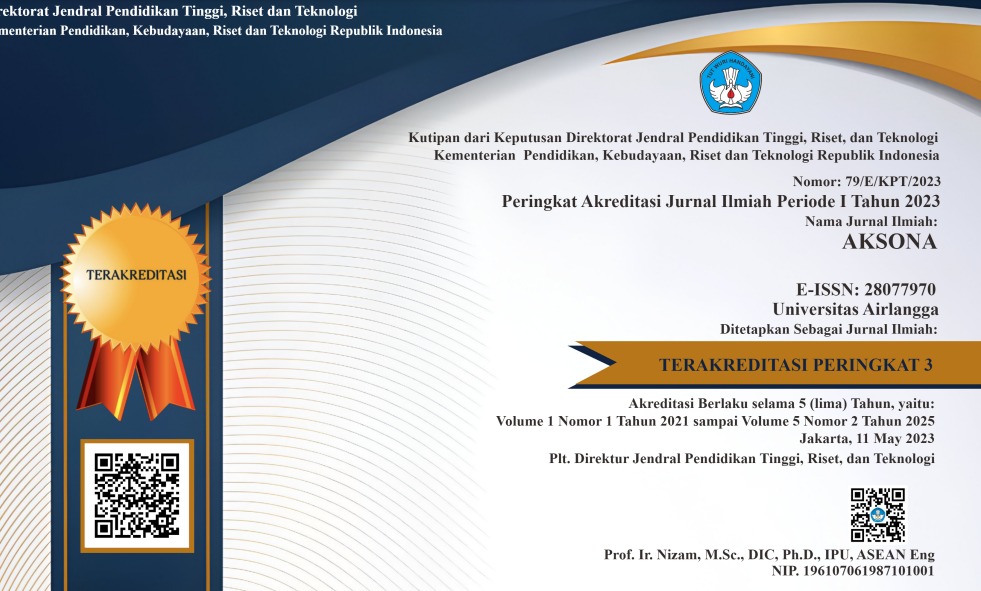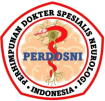Profile of Motoric and Non-Motoric Symptoms Using the Indonesian Version of the Wearing-Off Questionnaire-19 in Parkinson’s Patients
Downloads
Highlight:
- Tremors are the most common motor symptom in patients with Parkinson's disease.
- Abdominal discomfort is a prevalent non-motor symptom of Parkinson's disease.
- Comprehensive symptom management is essential for patients with Parkinson's disease.
ABSTRACT
Introduction: Parkinson's disease is a neurodegenerative disorder characterized by motor and non-motor symptoms. The prolonged administration of levodopa in patients may induce the wearing-off phenomenon, where symptoms recur before the next dose. Studies on the symptom profile of Parkinson's disease, especially in wearing-off conditions, are crucial for further management. Objective: This study aimed to determine the motor and non-motor symptom profile of patients with Parkinson's disease. Methods: conducted. The Indonesian version of the Wearing-Off Questionnaire-19 (WOQ-19) was used to identify motor and non-motor symptoms. Data were collected from 30 Parkinson’s patients at Bethesda Yogyakarta Hospital from October to December 2023 using a purposive sampling technique. The sample size was calculated using OpenEpi V3.01. Results: The most prevalent motor symptom among patients with Parkinson's disease was tremor (100%), followed by bradykinesia (93.33%) and rigidity (86.67%). The most common non-motor symptoms reported were abdominal discomfort (56.67%) and body aches (50%). Conclusion:Patients have a variety of Parkinson's disease symptoms. Parkinson's patients most commonly experienced motor symptoms such as tremors, bradykinesia, and rigidity, along with non-motor symptoms like abdominal discomfort and body aches. The significant percentage of wearing-off seen in this study underscores its common occurrence and highlights the importance of early identification and management.
Zafar S, Yaddanapudi SS. Parkinson disease. In: StatPearls. Treasure Island (FL): StatPearls Publishing; 2023. [Book]
Dorsey ER, Elbaz A, Nichols E, Abbasi N, Abd-Allah F, Abdelalim A, et al. Global, regional, and national burden of Parkinson’s disease, 1990–2016: A systematic analysis for the Global Burden of Disease Study 2016. Lancet Neurol. 2018; 17(11):939–53. doi: 10.1016/S1474-4422(18)30295-3
Su D, Cui Y, He C, Yin P, Bai R, Zhu J, et al. Projections for prevalence of Parkinson’s disease and its driving factors in 195 countries and territories to 2050: Modelling study of Global Burden of Disease Study 2021. BMJ. 2025; 388:e080952 doi: 10.1136/bmj-2024-080952
Jankovic J, Tan EK. Parkinson’s disease: Etiopathogenesis and treatment. J Neurol Neurosurg Psychiatry. 2020; 91(8):795–808. doi: 10.1136/jnnp-2019-322338
World Health Organization. Parkinson disease. 2023. [Web page]
Matthews H, Stamford J, Saha R, Martin A. Exploringissue around wearing-off and quality of life: The OFF-PARK survey of people with Parkinson’s disease and their care partners. J Parkinsons Dis. 2015; 5(3):533–9. doi: 10.3233/JPD-150547
Halli-Tierney AD, Luker J, Carroll DG. Parkinson disease. Am Fam Physician. 2020; 102(11):679–91. [Journal]
Reich SG, Savitt JM. Parkinson’s disease. Med Clin North Am. 2019; 103(2):337–50. doi: 10.1016/j.mcna.2018.10.014
Bhidayasiri R, Hattori N, Jeon B, Chen R-S, Lee MK, Bajwa JA, et al. Asian perspectives on the recognition and management of levodopa ‘wearing-off’ in Parkinson’s disease. Expert Rev Neurother. 2015; 15(11):1285–97. doi: 10.1586/14737175.2015.1088783
Farzanehfar P, Woodrow H, Horne M. Assessment of wearing off in Parkinson’s disease using objective measurement. J Neurol. 2021; 268(3):914–22. doi: 10.1007/s00415-020-10222-w
Ha ULN, Tran TN, Le M, Dang THT, Vũ NA, Truong D. Validating the Vietnamese version of wearing – Off 19 questionnaire for patients with Parkinson’s disease. Clin Park Relat Disord. 2019; 1:37–40. doi: 10.1016/j.prdoa.2019.07.007
Stocchi F, Antonini A, Barone P, Tinazzi M, Zappia M, Onofrj M, et al. Early DEtection of wEaring off in Parkinson disease: The DEEP study. Parkinsonism Relat Disord. 2014; 20(2):204–11. doi: 10.1016/j.parkreldis.2013.10.027
Pinzon RT. Reability of Indonesia version Wearing-Off questionnaire. Mov Disord. 2023; 38(suppl 1). [Conference Proceedings]
Simon DK, Tanner CM, Brundin P. Parkinson disease epidemiology, pathology, genetics, and pathophysiology. Clin Geriatr Med. 2020; 36(1):1–12. doi: 10.1016/j.cger.2019.08.002
Cerri S, Mus L, Blandini F. Parkinson’s disease in women and men: What’s the difference? J Park Dis. 2019; 9(3):501–15. doi: 10.3233/JPD-191683
Lewis MM, Harkins E, Lee E-Y, Stetter C, Snyder B, Corson T, et al. Clinical progression of Parkinson’s disease: Insights from the NINDS common data elements. J Parkinsons Dis. 2020; 10(3):1075–85. doi: 10.3233/JPD-201932
Remigio KC, Jamora RDG. Philippine translation and validation of the Wearing-off Questionnaire-19. Clin Park Relat Disord. 2019; 1:21–4. doi: 10.1016/j.prdoa.2019.07.005
Nugraha P, Hamdan M. Profil gejala motorik dan non-motorik pada pasien penyakit parkinson di RSUD Dr. Soetomo Surabaya. AKSONA. 2020; 1(5):154–8. [Journal]
Abbruzzese G, Antonini A, Barone P, Stocchi F, Tamburini T, Bernardi L, et al. Linguistic, psychometric validation and diagnostic ability assessment of an Italian version of a 19-item wearing-off questionnaire for wearing-off detection in Parkinson’s disease. Neurol Sci. 2012; 33(6):1319–27. doi: 10.1007/s10072-012-0943-y
Port RJ, Rumsby M, Brown G, Harrison IF, Amjad A, Bale CJ. People with Parkinson’s disease: What symptoms do they most want to improve and how does this change with disease duration. J Parkinsons Dis. 2021; 11(2):715–24. doi: 10.3233/JPD-202346
Prajjwal P, Flores Sanga HS, Acharya K, Tango T, John J, Rodriguez RSC, et al. Parkinson’s disease updates: Addressing the pathophysiology, risk factors, genetics, diagnosis, along with the medical and surgical treatment. Ann Med Surg. 2023; 85(10):4887–902. doi: 10.1097/MS9.0000000000001142
Baizabal-Carvallo JF, Alonso-Juarez M, Fekete R. The role of muscle strength in the sit-to-stand task in Parkinson’s disease. Colosimo C, editor. Parkinsons Dis. 2023; 2023:1–7. doi: 10.1155/2023/5016820
Chen R, Berardelli A, Bhattacharya A, Bologna M, Chen K-HS, Fasano A, et al. Clinical neurophysiology of Parkinson’s disease and parkinsonism. Clin Neurophysiol Pract. 2022;7:201–27. doi: 10.1016/j.cnp.2022.06.002
Dashtipour K, Tafreshi A, Lee J, Crawley B. Speech disorders in Parkinson’s disease: Pathophysiology, medical management and surgical approaches. Neurodegener Dis Manag. 2018; 8(5):337–48. doi: 10.2217/nmt-2018-0021
Li J, Zhu B-F, Gu Z-Q, Zhang H, Mei S-S, Ji S-Z, et al. Musculoskeletal pain in Parkinson’s disease. Front Neurol. 2022 ;12. doi: 10.3389/fneur.2021.756538
Sardar Z, Liaquat S, Yousaf Q, Bano S, Numan A. Non-Motor symptoms burden in early stages of Parkinson’s disease. Ann Indian Acad Neurol. 2023; 26(1):39–43. doi: 10.4103/aian.aian_483_22
Prakash K, Bannur B, Chavan M, Saniya K, Sailesh K, Rajagopalan A. Neuroanatomical changes in Parkinson′s disease in relation to cognition: An update. J Adv Pharm Technol Res. 2016;7(4):123–6. doi: 10.4103/2231-4040.191416
Pfeiffer RF. Non-motor symptoms in Parkinson’s disease. Parkinsonism Relat Disord. 2016 Jan; 22(Suppl 1):S119–22. doi: 10.1016/j.perkreldis.2015.09.004
Aarsland D, Batzu L, Halliday GM, Geurtsen GJ, Ballard C, Ray Chaudhuri K, et al. Parkinson disease-associated cognitive impairment. Nat Rev Dis Prim. 2021; 7(1):47. doi: 10.1038/s41572-021-00280-3
Raja K, Ramrakhia S, Dev K, Shahid W, Sohail H, Memon MK, et al. The risk factors for the wearing-off phenomenon in Parkinson’s disease. Cureus. 2020; 12(9):e10729. doi: 10.7759/cureus.10729
Choi J, Horner KA. Dopamine agonists . In: StatPearls. Trasure Island (FL): StatPearls Publishing; 2023. [Book]
Aradi SD, Hauser RA. Medical management and prevention of motor complications in Parkinson’s disease. Neurotherapeutics. 2020; 17(4):1339–65. doi: 10.1007/s13311-020-00889-4
Church FC. Treatment options for motor and non-motor symptoms of Parkinson’s disease. Biomolecules. 2021; 1 1(4):612. doi: 10.3390/biom11040612
Copyright (c) 2025 Bernadetha Muktiarini, Rizaldy Taslim Pinzon, Yacobus Christian Prasetyo

This work is licensed under a Creative Commons Attribution-ShareAlike 4.0 International License.





















